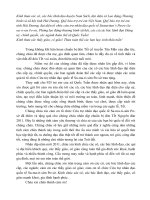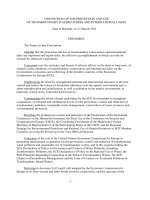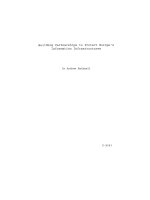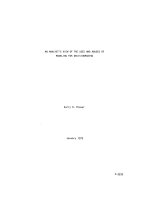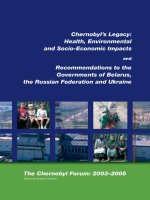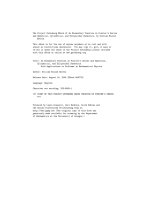Planning Tool to Support Louisiana''''s Decisionmaking on Coastal Protection and Restoration potx
Bạn đang xem bản rút gọn của tài liệu. Xem và tải ngay bản đầy đủ của tài liệu tại đây (1.19 MB, 106 trang )
GULF STATES POLICY INSTITUTE
A study by RAND Infrastructure, Safety, and Environment
For More Information
Visit RAND at www.rand.org
Explore the RAND Gulf States Policy Institute
View document details
Support RAND
Purchase this document
Browse Reports & Bookstore
Make a charitable contribution
Limited Electronic Distribution Rights
is document and trademark(s) contained herein are protected by law as indicated in a notice appearing
later in this work. is electronic representation of RAND intellectual property is provided for non-
commercial use only. Unauthorized posting of RAND electronic documents to a non-RAND website is
prohibited. RAND electronic documents are protected under copyright law. Permission is required from
RAND to reproduce, or reuse in another form, any of our research documents for commercial use. For
information on reprint and linking permissions, please see RAND Permissions.
Skip all front matter: Jump to Page 16
e RAND Corporation is a nonprot institution that helps improve policy and
decisionmaking through research and analysis.
is electronic document was made available from www.rand.org as a public service
of the RAND Corporation.
CHILDREN AND FAMILIES
EDUCATION AND THE ARTS
ENERGY AND ENVIRONMENT
HEALTH AND HEALTH CARE
INFRASTRUCTURE AND
TRANSPORTATION
INTERNATIONAL AFFAIRS
LAW AND BUSINESS
NATIONAL SECURITY
POPULATION AND AGING
PUBLIC SAFETY
SCIENCE AND TECHNOLOGY
TERRORISM AND
HOMELAND SECURITY
is product is part of the RAND Corporation technical report series. Reports may
include research ndings on a specic topic that is limited in scope; present discussions
of the methodology employed in research; provide literature reviews, survey instru-
ments, modeling exercises, guidelines for practitioners and research professionals, and
supporting documentation; or deliver preliminary ndings. All RAND reports un-
dergo rigorous peer review to ensure that they meet high standards for research quality
and objectivity.
TECHNICAL REPORT
Planning Tool to Support
Louisiana’s Decisionmaking
on Coastal Protection
and Restoration
Technical Description
David G. Groves
•
Christopher Sharon
•
Debra Knopman
GULF STATES POLICY INSTITUTE
A study by RAND Infrastructure, Safety, and Environment
Sponsored by the Coastal Protection and Restoration Authority of Louisiana
The RAND Corporation is a nonprofit institution that helps improve policy and
decisionmaking through research and analysis. RAND’s publications do not necessarily
reflect the opinions of its research clients and sponsors.
R
®
is a registered trademark.
© Copyright 2012 RAND Corporation
Permission is given to duplicate this document for personal use only, as long as it
is unaltered and complete. Copies may not be duplicated for commercial purposes.
Unauthorized posting of RAND documents to a non-RAND website is prohibited. RAND
documents are protected under copyright law. For information on reprint and linking
permissions, please visit the RAND permissions page (
permissions.html).
Published 2012 by the RAND Corporation
1776 Main Street, P.O. Box 2138, Santa Monica, CA 90407-2138
1200 South Hayes Street, Arlington, VA 22202-5050
4570 Fifth Avenue, Suite 600, Pittsburgh, PA 15213-2665
RAND URL:
To order RAND documents or to obtain additional information, contact
Distribution Services: Telephone: (310) 451-7002;
Fax: (310) 451-6915; Email:
Library of Congress Control Number: 2012947921
ISBN: 978-0-8330-7698-4
This research was sponsored by the Coastal Protection and Restoration Authority of the
State of Louisiana and was conducted in the RAND Gulf States Policy Institute and the
Environment, Energy, and Economic Development Program within RAND Infrastructure,
Safety, and Environment.
iii
Preface
Coastal Louisiana’s built and natural environment faces risks from catastrophic tropical storms,
such as Hurricanes Katrina and Rita in 2005 and Gustav and Ike in 2008. Hurricanes ood
cities, towns, and farmlands, forcing evacuations, damaging and destroying buildings and
infrastructure, eroding coastal habitats, and threatening the health and safety of residents.
Concurrently, the region is experiencing a dramatic conversion of coastal land and associated
habitats to open water and a loss of important services provided by such ecosystems. e State
of Louisiana, through its Coastal Protection and Restoration Authority (CPRA), responded to
the threat of catastrophic hurricanes and ongoing land loss by engaging in a detailed model-
ing, simulation, and analysis exercise, the results of which informed Louisiana’s Comprehensive
Master Plan for a Sustainable Coast (CPRA, 2012c).
e Master Plan denes a set of coastal risk-reduction and restoration projects to be
implemented in the coming decades to reduce hurricane ood risk to coastal communities
and restore the Louisiana coast. When selecting projects to reduce the ood eects of hurri-
canes, CPRA evaluated the extent to which each project might reduce damage. Similarly, when
choosing projects to restore the landscape, CPRA evaluated the extent to which each project
might sustain or build new land and support various ecosystem-service benets to the region.
Based on these evaluations, risk-reduction and restoration projects were selected to provide
the greatest level of risk-reduction and land-building benets under a given budget constraint
while being consistent with other objectives and principles of the Master Plan.
CPRA asked RAND to support the development of the Master Plan. One RAND proj-
ect team, with the guidance of CPRA and other members of the Master Plan Delivery Team,
developed a computer-based decision-support tool, called the CPRA Planning Tool. e Plan-
ning Tool provided technical analysis that supported the development of the Master Plan
through CPRA and community-based deliberations. e Master Plan was presented to the
Louisiana legislature in April 2012 and adopted for approval on May 22, 2012. CPRA sup-
ported a Technical Advisory Committee (Planning Tool—TAC), made up of three national
experts on coastal and natural resource planning, to provide technical review of the Planning
Tool and this document. Another RAND team developed a new model of coastal hurricane
ood risk to evaluate risk-reduction projects in support of the Master Plan, to be described in
another RAND document (Fischbach et al., forthcoming).
is document seeks to provide an accessible technical description of the Planning Tool
and associated analyses used to develop the Master Plan. e intended audience includes plan-
ners, stakeholders, and others in Louisiana and elsewhere in the United States and in other
countries who are interested in understanding the technical basis for the investments proposed
in the Master Plan.
iv Planning Tool to Support Louisiana’s Decisionmaking on Coastal Protection and Restoration
The RAND Environment, Energy, and Economic Development Program
is research was conducted in the Environment, Energy, and Economic Development Pro-
gram (EEED) within RAND Infrastructure, Safety, and Environment (ISE). e mission of
ISE is to improve the development, operation, use, and protection of society’s essential physical
assets and natural resources and to enhance the related social assets of safety and security of
individuals in transit and in their workplaces and communities. e EEED research portfolio
addresses environmental quality and regulation, energy resources and systems, water resources
and systems, climate, natural hazards and disasters, and economic development—both domes-
tically and internationally. EEED research is conducted for government, foundations, and the
private sector.
Information about EEED is available online ( Inquiries
about EEED projects should be sent to the following address:
Keith Crane, Director
Environment, Energy, and Economic Development Program, ISE
RAND Corporation
1200 South Hayes Street
Arlington, VA 22202-5050
703-413-1100, x5520
RAND Gulf States Policy Institute
RAND created the Gulf States Policy Institute in 2005 to support hurricane recovery and
long-term economic development in Louisiana, Mississippi, and Alabama. Today, RAND
Gulf States provides objective analysis to federal, state, and local leaders in support of evidence-
based policymaking and the well-being of individuals throughout the Gulf Coast region. With
oces in New Orleans, Louisiana, and Jackson, Mississippi, RAND Gulf States is dedicated
to helping the region address a wide range of challenges that include coastal risk reduction and
restoration, health care, and workforce development. More information about RAND Gulf
States can be found at />Questions or comments about this report should be sent to the project leaders, David
Groves () or Debra Knopman ().
v
Contents
Preface iii
Figures
ix
Tables
xi
Summary
xiii
Acknowledgments
xix
Abbreviations
xxi
CHAPTER ONE
Introduction 1
Planning Objectives
2
Planning Under Uncertainty
2
Purpose of the Planning Tool
3
CHAPTER TWO
Model Description and Assumptions 5
Predictive Modeling Framework
5
Formulation of Alternatives
6
Basis of the Approach in Decision eory
7
Objective Function and Developing Alternatives Using Optimization
8
Risk-Reduction Decision Driver
8
Land-Building Decision Driver
9
Objective Function
9
Metrics and Decision Criteria
11
Metrics
11
Decision Criteria
12
Constraints
16
Financial and Natural Resource Constraints
17
Mutually Exclusive Project and Project Inclusion or Exclusion Constraints
18
Outcome Constraints
19
Modeling Projects Under Dierent Scenarios
19
Environmental Scenarios
20
Funding Scenarios
21
Key Assumptions in the Development of Alternatives
21
Risk-Reduction Projects Do Not Aect the Landscape or Ecosystem-Service Metrics, and
Restoration Projects and Landscape Changes Do Not Aect Storm-Surge Risk
21
Physical and Biological Eects of Individual Projects Are Additive
21
vi Planning Tool to Support Louisiana’s Decisionmaking on Coastal Protection and Restoration
Funding Scenarios Are Known 22
Funding Is Available for the Entire Implementation Period
22
Funding Cannot Be Saved for Use in Later Implementation Periods
22
Projects Begin Planning and Design in the First Year of an Implementation Period
23
Project Eects Are Oset by Planning, Design, and Construction Time
23
Projects Must Continually Operate
23
Handling and Processing of Data Within the Planning Tool
23
MySQL Database
23
Analytica Module
24
General Algebraic Modeling System Optimization Module
24
Tableau Results Visualizer
24
CHAPTER THREE
Analytic Procedures 27
Characterization of Projects
27
Project Costs and Duration of Implementation
28
Conicts Among Projects
29
Additional Project Attribute Information
29
Modeling Project Eects
29
Flood Risk-Reduction Eects
30
Restoration Project Eects
30
Comparison of Individual Projects
30
Project Eects on Risk Reduction
31
Project Eects on Land and Ecosystem-Service Metrics
32
Project Eects Relative to Other Decision Criteria
33
Cost-Eectiveness
33
Formulation of Alternatives
33
Integrated Evaluation of Alternatives
34
Evaluation of Selected Alternatives Using Predictive Models Under Uncertainty
34
Comparisons of the Alternatives
35
CHAPTER FOUR
Analyses to Develop the Master Plan 37
Compare Individual Projects
37
Formulate Alternatives
38
Establish the Funding Target and Funding Split
40
Dene the Near-Term and Long-Term Balance
43
Assess Performance Under Uncertainty
47
Develop Alternatives to Meet Master Plan Objectives
48
Adjust Alternatives Using Expert Judgment
55
Dene the Draft Master Plan
60
Review Projects and Outcomes for Dierent Alternatives
60
Dene the Final Master Plan
61
Revise Project Data
63
Evaluate Public Comments
63
Revise the Draft Alternative for the Final Master Plan
63
Contents vii
Review Master Plan Projects and Outcomes 63
Post–Master Plan Analysis
66
CHAPTER FIVE
Conclusions 73
APPENDIX
Expert-Adjusted Alternatives 75
Glossary
79
References
81
ix
Figures
S.1. Locations of Restoration Projects Evaluated by the Planning Tool xiv
S.2. Long-Term Risk Reduction and Long-Term Land Building for Dierent Funding
Splits and Funding Scenarios
xv
S.3. Master Plan Funding, by Project Type (millions of 2010 dollars)
xvii
S.4. Coast-Wide Flood Risk for Current Conditions, Year 50 Without the Master Plan,
and Year 50 with the Master Plan for the Moderate and Less Optimistic Scenarios
xvii
S.5. Change in Land Area With and Without the Master Plan for the Moderate
Scenario
xviii
S.6. Change in Land Area With and Without the Master Plan for the Less Optimistic
Scenario
xviii
2.1. Linkages and Feedbacks Among Predictive Models
6
2.2. Illustration of Two Alternatives and eir Scores Relative to Land-Area Use of
Natural Processes
20
2.3. Two Screen Shots of the Public Version of the Planning Tool Results Visualizer
25
3.1. Locations of Risk-Reduction Projects Evaluated by the Planning Tool
28
3.2. Locations of Restoration Projects Evaluated by the Planning Tool
28
3.3. Map of the Communities and Regions at Summarize Risk Outcomes
30
3.4. Map of the Regions at Summarize Ecosystem-Service Metrics
31
4.1. Planning Tool Analysis and Outcomes for the Master Plan
37
4.2. Cost-Eectiveness Scores for the 20 Most Cost-Eective Risk-Reduction Projects
41
4.3. Cost-Eectiveness Scores for the Ten Most Cost-Eective Diversion Projects
41
4.4. Cost-Eectiveness Scores for the Ten Most Cost-Eective Marsh-Creation Projects
42
4.5. Long-Term Risk Reduction and Long-Term Land Building for Dierent Funding
Splits and Total Funding Level
43
4.6. Structural Risk-Reduction Projects Selected for Alternatives with Dierent Balances
Between Near-Term and Long-Term Benets
45
4.7. Trends in Coast-Wide Land Area over Time for Moderate Future Conditions
45
4.8. Near-Term and Long-Term Land-Building Results for Dierent
Balances Between Near-Term and Long-Term Outcomes
46
4.9. Change in Restoration Project Expenditures, by Project Type, for Dierent
Near-Term/L ong-Term Ba lances
47
4.10. Comparison of Land Area in Year 50 for Alternatives Developed to Maximize Land
Under Either the Moderate or Less Optimistic Scenario
48
4.11. Reduction in Risk Versus the Use of Natural Processes Decision Criterion for Ten
Alternatives
52
4.12. Structural Risk-Reduction Projects Included for Alternatives Generated by
Imposing Constraints on the Use of Natural Processes
53
4.13. Trade-Os Between Change in Land by Year 50 and Shrimp
54
x Planning Tool to Support Louisiana’s Decisionmaking on Coastal Protection and Restoration
4.14. Trade-Os Between Change in Land by Year 50 and Saltwater Fisheries 54
4.15. Trade-Os Between Land Area Built by Year 50 and Dierent Decision-Criterion
Scores
56
4.16. Sediment Diversion Projects Included in Alternatives at Vary the Support for
Navigation Criterion
57
4.17. Master Plan Funding, by Project Type (millions of 2010 dollars)
64
4.18. Coast-Wide Flood Risk for Current Conditions, Year 50 Without the Master Plan,
and Year 50 with the Master Plan for the Moderate and Less Optimistic Scenarios
65
4.19. Change in Land Area With and Without the Master Plan for the Moderate
Scenario
65
4.20. Change in Land Area With and Without the Master Plan for the Less Optimistic
Scenario
66
4.21. Comparison of Coast-Wide Expected Annual Damage (billions of 2010 dollars)
in 2061 Under Future-Without-Action Conditions and with Master Plan Estimates
Using the Planning Tool and the Integrated Analysis for Two Environmental
Scenarios
67
4.22. Comparison of Expected Annual Damage (millions of 2010 dollars) in 2061 for
Houma, Greater New Orleans, and Slidell Under Future-Without-Action and with
Master Plan Conditions Using the Planning Tool and the Integrated Analysis for
the Moderate Scenario
68
4.23. Change in Land Area over Time with the Master Plan for the Moderate Scenario
as Estimated by the Planning Tool and the Integrated Analysis
69
4.24. Change in Land Area over Time with the Master Plan for the Less Optimistic
Scenario as Estimated by the Planning Tool and the Integrated Analysis
70
4.25. Ratio of Coast-Wide Ecosystem-Service Metric Outcome for Each Ecosystem-
Service Metric in Year 50 for the Moderate Scenario
71
xi
Tables
2.1. Time Periods Used for Allocating Funding over 50 Years and
Calculating Near-Term and Long-Term Benets
12
2.2. Decision Criteria Reecting Master Plan Objectives
14
2.3. Constraints Used to Formulate Alternatives
18
2.4. Funding Amounts ($ billions), by Time Period, for Two Funding Scenarios
21
3.1. Range of Individual Project Costs for Master Plan Projects, by Type
29
4.1. Range of Risk Reduction for Each Risk-Reduction Project Type, by Environmental
Scenario
39
4.2. Range of Net Land-Area Change for Each Restoration Project Type, by
Environmental Scenario
40
4.3. Decision Criteria and Metrics Constrained as Part of the Master Plan Sensitivity
Analysis
50
4.4. Frequency of Sediment Diversion Project Inclusion for Alternatives with Dierent
Decision-Criterion Constraints (%)
58
4.5. Constrained Alternatives Developed for the Master Plan
60
4.6. Risk-Reduction Decision-Criterion Scores for Expert-Adjusted Alternatives
61
4.7. Restoration Decision-Criterion Scores for Expert-Adjusted Alternatives
62
A.1. Projects Included and Excluded for Expert-Adjusted Alternatives
75
xiii
Summary
Louisiana’s Coastal Crisis
Coastal Louisiana is on an unsustainable trajectory of ongoing conversion of coastal land to
open water and increasing hurricane ood risk. Since the 1930s, 1,800 square miles of land
have been lost to open water (Couvillion et al., 2011). is loss of land is changing the nature of
the coastal environment profoundly and diminishing many of its benets, including habitats
for commercially and recreationally important species. Land loss is also decreasing the region’s
natural buer against hurricane storm surges.
e causes of the ongoing land loss are varied and include natural and human-caused
land subsidence, rising sea level, and the loss of nourishing sediment from Mississippi river
ows that is now deposited deep in the Gulf of Mexico. Without major investments in coastal
restoration, the Coastal Protection and Restoration Authority (CPRA) estimates that an addi-
tional 800 square miles could be lost over the next 50 years under moderate assumptions about
future conditions, and 1,800 square miles under less optimistic assumptions (CPRA, 2012a).
As communities and economic assets grow during the coming decades, the land that provides
a protected buer against storm surges is anticipated to continue to degrade. Sea-level rise and
subsidence rates may accelerate (Vermeer and Rahmstorf, 2009; Kolker, Allison, and Hameed,
2011), and hurricanes may increase in frequency and magnitude in response to changing cli-
mate patterns (Knutson et al., 2010). As a consequence, ood risk is expected to rise signi-
cantly if further investments in risk-reduction and restoration projects are not made.
The Louisiana Comprehensive Master Plan and Planning Tool
To address this challenge, CPRA developed Louisiana’s Comprehensive Master Plan for a Sus-
tainable Coast (CPRA, 2012c), a 50-year plan for reducing hurricane ood risk and achieving a
sustainable landscape. As part of this eort, CPRA supported the development of a computer-
based decision-support tool called the Planning Tool. e Planning Tool was designed to sup-
port a deliberation-with-analysis process by which quantitative analysis is used not to provide
a single answer but rather to frame and illuminate key policy trade-os (National Research
Council, 2009). Specically, the Planning Tool helped CPRA to (1) make analytical and objec-
tive comparisons of hundreds of dierent risk-reduction and restoration projects, (2) identify
and assess groups of projects (called alternatives) that could make up a comprehensive solution,
and (3) display the trade-os interactively to support iterative deliberation over alternatives.
xiv Planning Tool to Support Louisiana’s Decisionmaking on Coastal Protection and Restoration
Comparing Individual Risk-Reduction and Restoration Projects
e Planning Tool compares the ways in which individual projects aect the main objectives
of the Master Plan—reducing hurricane ood risk and building and maintaining the coastal
landscape. e Master Plan analyzed more than 40 structural risk-reduction projects, including
levees and oodwalls, and nonstructural programs across the coast that reduce ood damage
to residential and commercial structures through elevating, ood-proong, or removing the
structures. e Master Plan also analyzed approximately 250 restoration projects, including
bank stabilization, barrier island restoration, channel realignment, sediment diversion, hydro-
logic restoration, marsh creation, oyster barrier reef, ridge restoration, and shoreline protection
(FigureS.1).
e Planning Tool draws on results from computer models (called predictive models) that
estimate the hydrodynamic and ecological eects that risk-reduction projects can have on asset
damage and the eects of restoration projects on land building. Eects were considered for
a range of risk-reduction, landscape, and ecosystem-service metrics and were made for two
dierent environmental scenarios: moderate and less optimistic. e less optimistic scenario
assumed higher sea-level rise and subsidence rates along with more-frequent and more-intense
hurricanes than for the moderate scenario.
Specically, the predictive models estimated the eects of risk-reduction projects on
residual damage at three recurrence intervals (50, 100, and 500years) across 56communi-
ties in coastal Louisiana. Similarly, the models estimated the eects of restoration projects on
14ecosystem-service metrics across 12 regions in coastal Louisiana. e Planning Tool also
evaluated the eects of projects and alternatives on 11additional decision criteria, such as sup-
port of navigation and use of natural processes, using project-specic information along with the
risk-reduction and ecosystem-service eects of the projects.
FigureS.1
Locations of Restoration Projects Evaluated by the Planning Tool
NOTE: Each symbol represents an individual project that may cover a much larger area than the symbol itself does,
such as an entire parish.
RAND TR1266–S.1
Project type
Bank stabilization
Barrier island or headland restoration
Channel realignment
Sediment diversion
Hydrologic restoration
Marsh creation
Oyster barrier reef
Ridge restoration
Shoreline protection
Longitude
–89.5–90.0–90.5–91.0–91.5–92.0–92.5–93.0
–93.5–94.0
28.5
29.0
29.5
30.0
30.5
–89.0
Latitude
Summary xv
Formulating Alternative Comprehensive Solutions
e Planning Tool identi es alternatives (groups of projects) over a 50-year planning hori-
zon using an optimization model. e Planning Tool uses a mixed-integer program (MIP) to
identify alternatives that minimize coast-wide risk to economic assets through risk-reduction
projects and maximize coast-wide land building through restoration projects while satisfying a
set of constraints. Speci cally, an alternative’s estimated costs cannot exceed available funding,
sediment requirements cannot exceed available sediment resources, and river ow from diver-
sions cannot reduce downstream ows below an acceptable level.
CPRA used the Planning Tool to iteratively develop and evaluate a large set of alter-
natives. For each iteration, the RAND team used the Planning Tool to formulate di erent
alternatives. ese results were provided to CPRA through an interactive, computer-based
interface. CPRA then reviewed the analysis, shared selected results with its stakeholders, and
provided the RAND team with revised speci cations for additional alternatives.
is iterative process helped inform CPRA decisions about allocating funding between
risk-reduction and restoration projects and the relative emphasis to place on near-term versus
long-term bene ts. Figure S.2, for example, shows estimates of long-term coast-wide land
FigureS.2
Long-Term Risk Reduction and Long-Term Land Building for Different Funding
Splits and Funding Scenarios
Long-term reduction in coast-wide EAD (%)
Long-term increases in land (% toward current
coast-wide levels)
70%/30%
70%/30%
70%/30%
70%/30%
70%/30%
60%/40%
60%/40%
60%/40%
60%/40%
60%/40%
50%/50%
50%/50%
50%/50%
50%/50%
50%/50%
40%/60%
40%/60%
40%/60%
40%/60%
40%/60%
30%/70%
30%/70%
30%/70%
30%/70%
30%/70%
(% risk reduction/% restoration)
125
120
115
110
105
100
95
90
85
80
75
70
65
60
55
50
9085807570656055 95
NOTE: Percentage of risk reduction is presented as a percentage of future without action
(FWOA) expected annual damage (EAD) from flooding. EAD represents the monetary
damage that would occur, on average, as a result of flooding from category 3 or greater
storms in any given year, if a particular region were subjected to the same specific
conditions and probability distribution of flood depths over many years. Land building is
presented as a percentage of land lost under FWOA conditions. Long-term results are
those for year 50. Symbols indicate different funding scenarios. Labels indicate different
funding splits (risk reduction/restoration). Results are for the moderate scenario. Results
for a 50/50 split are colored red.
RAND TR1266–S.2
Funding scenario
($ billions)
20 (low funding)
30
40
50 (high funding)
100
xvi Planning Tool to Support Louisiana’s Decisionmaking on Coastal Protection and Restoration
area (vertical axis) and long-term coast-wide risk reduction (horizontal axis) for alternatives
that dier in terms of total available funding (symbol) and dierent allocations between risk-
reduction and restoration projects (labels and coloring). is gure helped CPRA decide to
develop the Master Plan around a $50 billion budget and to allocate funding equally to risk-
reduction and restoration projects.
Deliberating over Alternatives to Develop the Master Plan
RAND developed several versions of a visualizer of Planning Tool results to support the Master
Plan deliberations. Each version contained specic visualizations based on a set of Planning
Tool evaluations stored in an internal database. ese visualizations were used to support
numerous workshops with stakeholders and meetings with CPRA management and other key
decisionmakers.
CPRA used the Planning Tool to support its selection of the specic alternative that
serves as the foundation of the 50-year, $50 billion 2012 Louisiana’s Comprehensive Master Plan
for a Sustainable Coast. e draft Master Plan (CPRA, 2012a) was released in January 2012
for public review and comment. CPRA subsequently held three all-day public meetings and
more than 50 meetings with community groups, parish ocials, legislators, and stakeholder
groups. CPRA then used the Planning Tool to reformulate alternatives based on revised proj-
ect information and input from public comments. is information helped develop the nal
Master Plan (CPRA, 2012c), which was presented to the Louisiana legislature in April 2012
and passed into law in May 2012.
The 2012 Master Plan
e 2012 Master Plan is the rst comprehensive solution for Louisiana’s coast to receive broad
support from the Louisiana public and the many agencies, federal, state, and local, engaged
in protecting the Gulf Coast. It is based on $50 billion of funding (in 2010 dollars) over the
next 50 years allocated broadly across the coast and among dierent project types (FigureS.3).
e Planning Tool estimates that implementation of the Master Plan would dramatically
decrease coast-wide ood risk from a currently estimated level of $2.4 billion on average today
to between $2.4 billion and $5.5 billion in year50 with the full implementation of the Master
Plan (FigureS.4). Without the Master Plan in place, EAD could exceed $23billion under the
less optimistic scenario.
e Planning Tool also estimates that the Master Plan, under moderate assumptions,
would stabilize the coastal land area by around 2040 and increase land thereafter (FigureS.5).
Under less optimistic assumptions, however, coast-wide land area never stabilizes, and land
loss would be severe (FigureS.6). is result suggests that it will be critical to adapt the Master
Plan if sea level rises and other key conditions are less favorable than those in the moderate
scenario.
e Planning Tool played a critical role in the development of CPRA’s Master Plan by
providing information to support the deliberation needed to formulate a single 50-year plan. It
provided a structured, analytic framework for comparing dierent risk-reduction and restora-
tion projects, formulating many dierent alternatives, each representing one possible compre-
hensive approach to solving the coast’s ood risk and land-loss problems. e resulting 50-year
Master Plan received strong public support and passed the Louisiana legislature unanimously
in May 2012.
Summary xvii
FigureS.3
Master Plan Funding, by Project Type (millions of 2010 dollars)
NOTE: The numbers in parentheses indicate the number of projects of each type included
in the Master Plan. Funding is rounded to the nearest $100 million
RAND TR1266-S.3
$200—Bank stabilization (5)
$1,700—Barrier island
restoration (4)
$100—Channel realignment (1)
$700—Hydrologic
restoration (15)
$400—Ridge restoration (15) $1,700—Shoreline protection (14)
$10,900—Structural
protection (17)
$10,200—
Nonstructural
protection (42)
$4,000—
Sediment
diversion (11)
$22,000—Marsh
creation (25)
$100—Oyster barrier reef (3)
FigureS.4
Coast-Wide Flood Risk for Current Conditions, Year 50 Without the Master Plan, and Year 50 with
the Master Plan for the Moderate and Less Optimistic Scenarios
RAND TR1266-S.4
7.7
2.4
2.4
23.4
5.5
0
5
10
15
20
25
30
35
Current Year 50
(without Master Plan)
Time frame
Year 50
(with Master Plan)
Less optimistic
Moderate
Scenario
Coast-wide flood risk (EAD, $ billions)
xviii Planning Tool to Support Louisiana’s Decisionmaking on Coastal Protection and Restoration
FigureS.6
Change in Land Area With and Without the Master Plan for the Less Optimistic Scenario
2011 2021 2031 2041 2051 2061
–2,000
–1,800
–1,600
–1,400
–1,200
–1,000
–800
–600
–400
–200
0
RAND TR1266–S.6
Change in land area from present (sq. mi.)
With Master Plan
FWOA
Year
FigureS.5
Change in Land Area With and Without the Master Plan for the Moderate Scenario
RAND TR1266–S.5
–900
–800
–700
–600
–500
–400
–300
–200
–100
0
2011 2021 2031 2041 2051 2061
With Master Plan
FWOA
Change in land area from present (sq. mi.)
Year
xix
Acknowledgments
We would like to thank the sta of the Coastal Protection and Restoration Authority (CPRA)
for their support throughout the Master Plan eort. We would especially like to thank Kirk
Rhinehart, Natalie Snider, Karim Belhadjali, and Melanie Saucier of CPRA for their support
and guidance. Members of the Planning Tool Technical Advisory Committee—John Boland,
BenjaminF. Hobbs, and Leonard Shabman—the Master Plan’s Science Engineering Board,
and internal RAND reviewers have provided thoughtful reviews and helpful advice at various
stages of development. Collaboration by our partners, Brown and Caldwell and the University
of New Orleans, has been greatly appreciated; Cindy Paulson, Joanne Chamberlain, Alaina
Owens, Joe Wyble, and Stephanie Hanses of Brown and Caldwell and Denise J. Reed of
the University of New Orleans have been especially helpful throughout the process. We have
worked closely with Jordan Fischbach and DavidR. Johnson at RAND to ensure that the
results from the ood risk modeling were appropriately used in the Planning Tool. Finally, we
would like to thank Anna Smith of RAND and Keith Crane, director of RAND’s Environ-
ment, Energy, and Economic Development Program for their assistance throughout the eort.
xxi
Abbreviations
cfs cubic feet per second
CPRA Coastal Protection and Restoration Authority
csv comma-separated values
EAD expected annual damage
EEED Environment, Energy, and Economic Development Program
FEMA Federal Emergency Management Agency
FWOA future without action
FWP future with project
GAMS General Algebraic Modeling System
GIWW Gulf Intracoastal Waterway
Hazus Hazards—United States
ISE RAND Infrastructure, Safety, and Environment
LACPR Louisiana Coastal Protection and Restoration
MCDA multicriterion decision analysis
MIP mixed-integer program
O&M operations and maintenance
Planning Tool—TAC Technical Advisory Committee
USACE U.S. Army Corps of Engineers
1
CHAPTER ONE
Introduction
Coastal Louisiana is on an unsustainable trajectory of ongoing conversion of coastal land to
open water and increasing hurricane ood risk. e causes of the ongoing land loss are varied
and include natural and human-caused land subsidence, rising sea level, and the loss of nour-
ishing sediment from Mississippi River ows that is now deposited deep in the Gulf of Mexico.
Since the 1930s, 1,800 square miles have been lost (Couvillion et al., 2011). Without major
investments in coastal restoration, the Coastal Protection and Restoration Authority of Loui-
siana (CPRA) estimates that an additional 800 square miles of coastal land could be lost over
the next 50 years under moderate assumptions about future conditions, and 1,800 square miles
under less optimistic assumptions (CPRA, 2012a).
is loss of land is changing the nature of the coastal environment profoundly and dimin-
ishing many of its benets, including habitats for commercially and recreationally important
species. Land loss is also increasing hurricane ood risk because coastal land provides the rst
line of defense against storm surge. As tragically demonstrated by the ooding and levee fail-
ures caused by Hurricane Katrina and later damage from Hurricane Rita in 2005, many of
Louisiana’s residents and commercial and business establishments face high levels of risk to hur-
ricane storm-surge ooding. Hurricane Katrina, for example, inicted $8billion to $10billion
in direct damage to New Orleans residences alone, with 200,000 homes and 15,000 apartment
units destroyed in the city (Grossi and Muir-Wood, 2006; Brinkley, 2006).
CPRA estimates that Louisiana currently faces an average of $2.4 billion of damage annu-
ally just to residences, commercial buildings, and industrial structures.
1
As communities and
economic assets grow during the coming decades, the land that provides a protective buer is
anticipated to continue to degrade. Sea-level rise and subsidence rates may accelerate (Vermeer
and Rahmstorf, 2009; Kolker, Allison, and Hameed, 2011), and hurricanes may increase in
frequency and magnitude in response to a changing climate (Knutson et al., 2010). As a conse-
quence, annual damage is expected to rise without investment in risk-reduction and restoration
projects. Under moderate estimates of future demographic and economic changes, sea-level
rise, subsidence, and changes in hurricanes, expected damage could increase to $7.7billion
per year in 50years. Under less optimistic estimates of future conditions, EAD could exceed
$23billion in 50 years.
To address this challenge, CPRA developed Louisiana’s Comprehensive Master Plan for a
Sustainable Coast (CPRA, 2012c) to dene a 50-year plan for reducing hurricane ood risk and
1
Expected annual damage (EAD) represents the monetary damage that would occur on average as a result of ooding
from category3 or greater storms in any given year, if a particular region were subjected to the same specic conditions
and probability distribution of ood depths over many years. In a given year, such as one in which a large hurricane makes
landfall, damage amounts would be much larger than the average EAD. In other years, no damage would occur.
